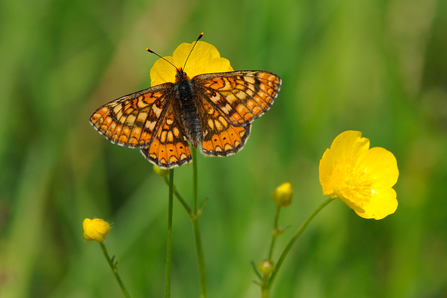The marsh fritillary is a beautiful sight, with chequerboard upper wings in hues of orange and cream that make it instantly recognisable in flight. Sadly, these stunning insects have disappeared across much of their range, with populations having declined by 80% since the 1970s. Loss and degradation of their marshy grassland habitat, coupled with the butterfly’s poor flying ability, has been a leading cause in the decline of this species. The marsh fritillary is one of Europe’s most threatened butterflies.
This is why the Trust and Butterfly Conservation decided to collaborate on a scheme to reintroduce this butterfly to north-east Hampshire. In 2009 the Trust began managing MoD land in the north-east of Hampshire which had been a last stronghold for the butterfly until its disappearance in the 1990s. Under the Trust’s management, the habitat was gradually brought back into a condition that would allow marsh fritillaries to thrive once more. A successful captive breeding programme followed, under licence from Natural England, using marsh fritillary larvae collected from healthy populations on Dartmoor. In 2018, the butterfly was officially reintroduced to several carefully selected meadows in a partnership between the conservation charities and the MoD, and local experts from the Hampshire Marsh Fritillary Action Group (HMFAG). By the summer of 2020, the marsh fritillary was doing well, with close to 200 adult butterflies recorded and plenty of caterpillars feeding on their food plant, Devil’s-bit scabious.
Acknowledging the substantial achievement of this successful reintroduction, the 2021 Sanctuary Awards, which recognise outstanding contributions across the Ministry of Defence estate, awarded the project the highly commended award in its class of Environmental Protection and Enhancement.
Richard Hennessey, Senior Reserves Officer for Hampshire & Isle of Wight Wildlife Trust said:
"I am very pleased that the marsh fritillary project has been recognised by the Sanctuary Awards, receiving Highly Commended in its class. It is a great achievement among some tough competition. The project demonstrates what can be accomplished collaboratively, and we would like to thank our partners Butterfly Conservation, the MoD and HMFAG for all their hard work with the reintroduction.”
Andy Barker, Chair of Hampshire and Isle of Wight Branch of Butterfly Conservation said:
“We’re delighted to have received this project award. We know that 76% of the UK’s butterfly species have declined in abundance, occurrence or both over the last 40 years and conservation projects like these are vital to stopping these declines. This work would have been impossible without our fantastic project partners and our thanks goes to the MoD and HMFAG.”
The Trust is delighted to receive such positive recognition for a project that has brought one of Britain’s most beautiful butterflies back from the brink of local extinction. The habitats needed by the marsh fritillary are home to myriad other species, and the reintroduction restores a missing piece of nature’s jigsaw to the area. Returning our missing species to the countryside is an integral part of our vision for a Wilder Hampshire and Isle of Wight. We look forward to seeing what the surveys hold for the 2021 season and watching this species go from strength to strength in our counties.
The project was funded through the generous support of Hampshire & Isle of Wight Wildlife Trust and Butterfly Conservation members, the Farnborough Airport Community Environmental Fund, the Ministry of Defence and the John Spedan Lewis Foundation.

